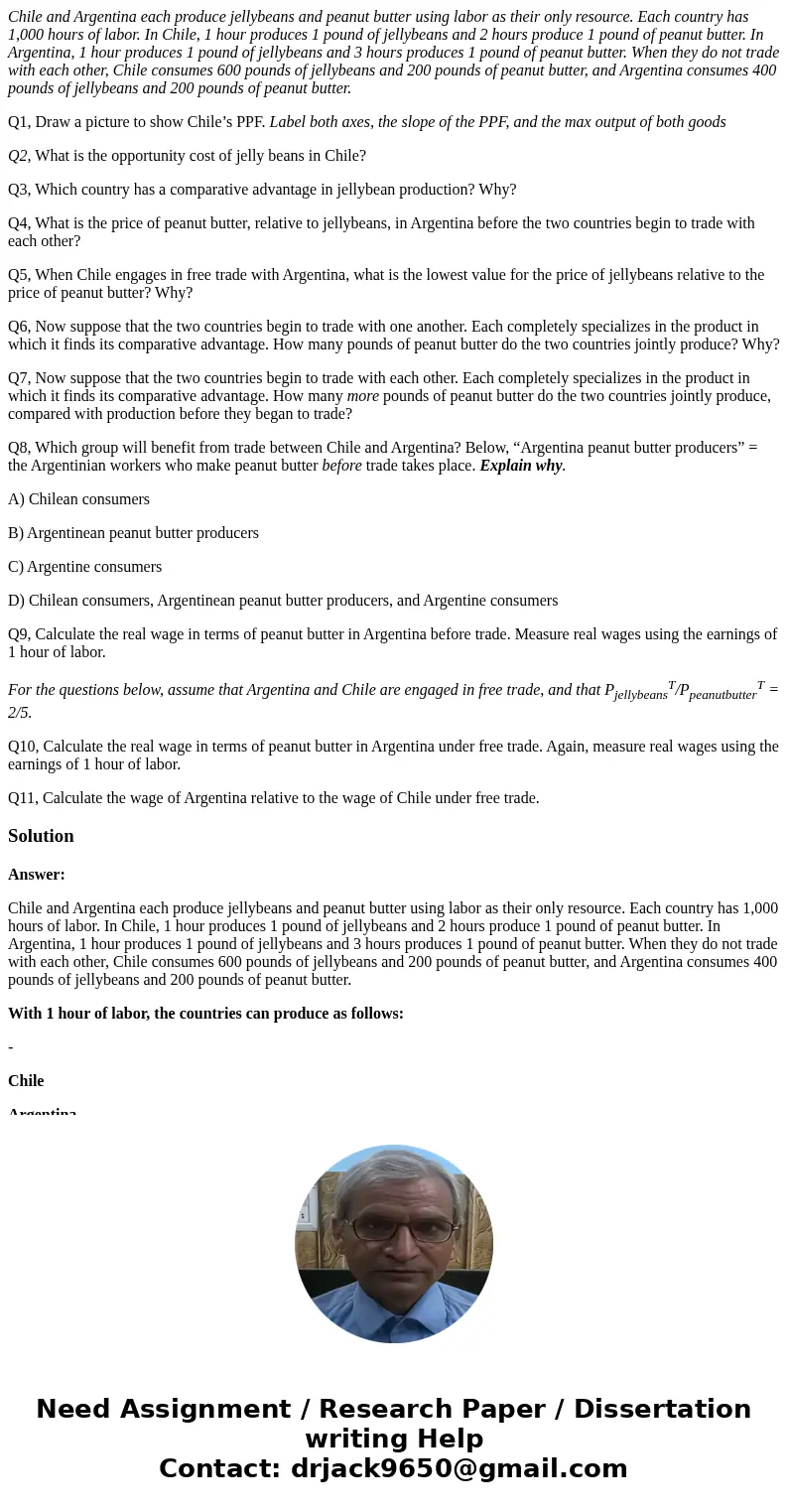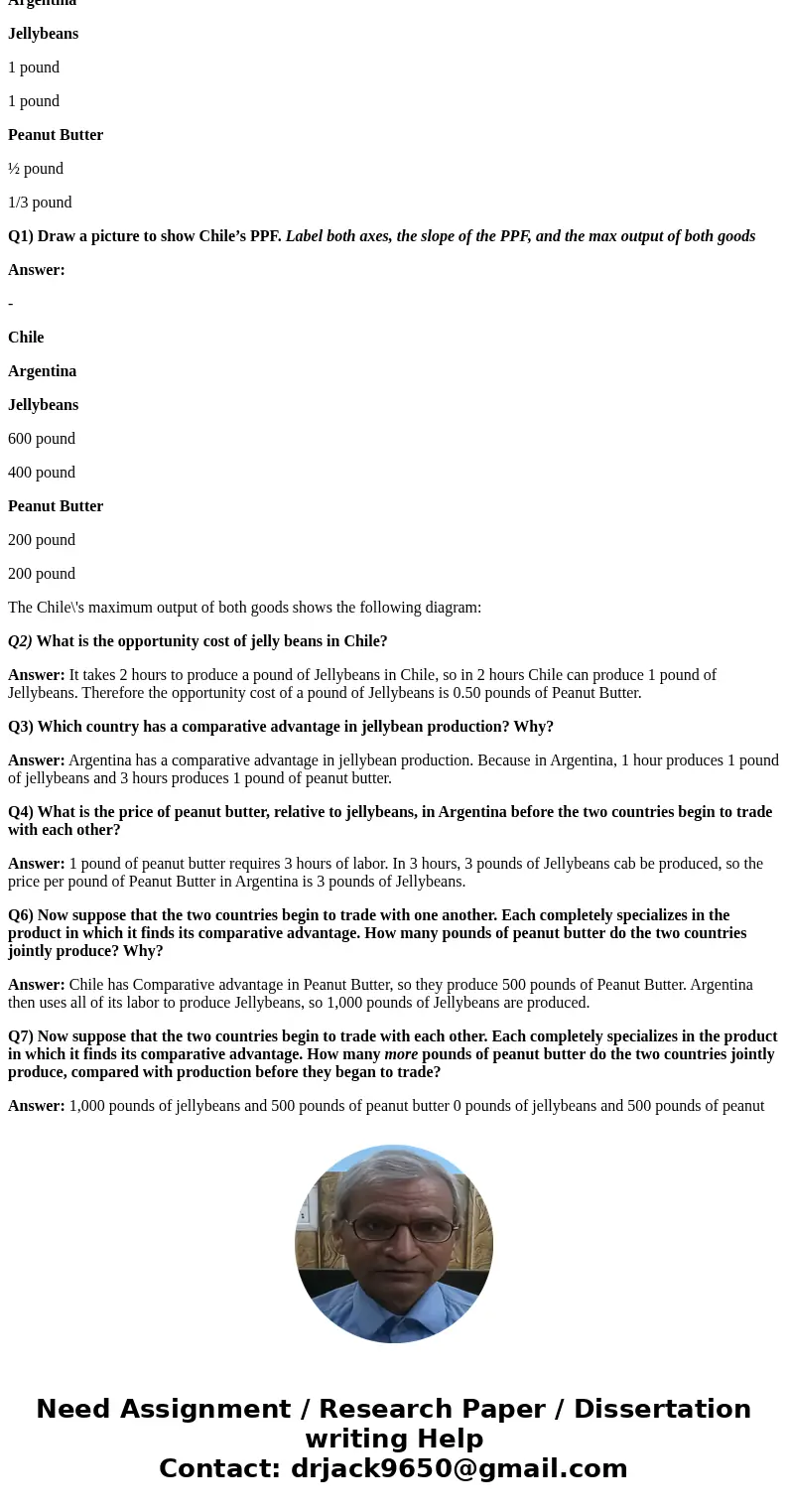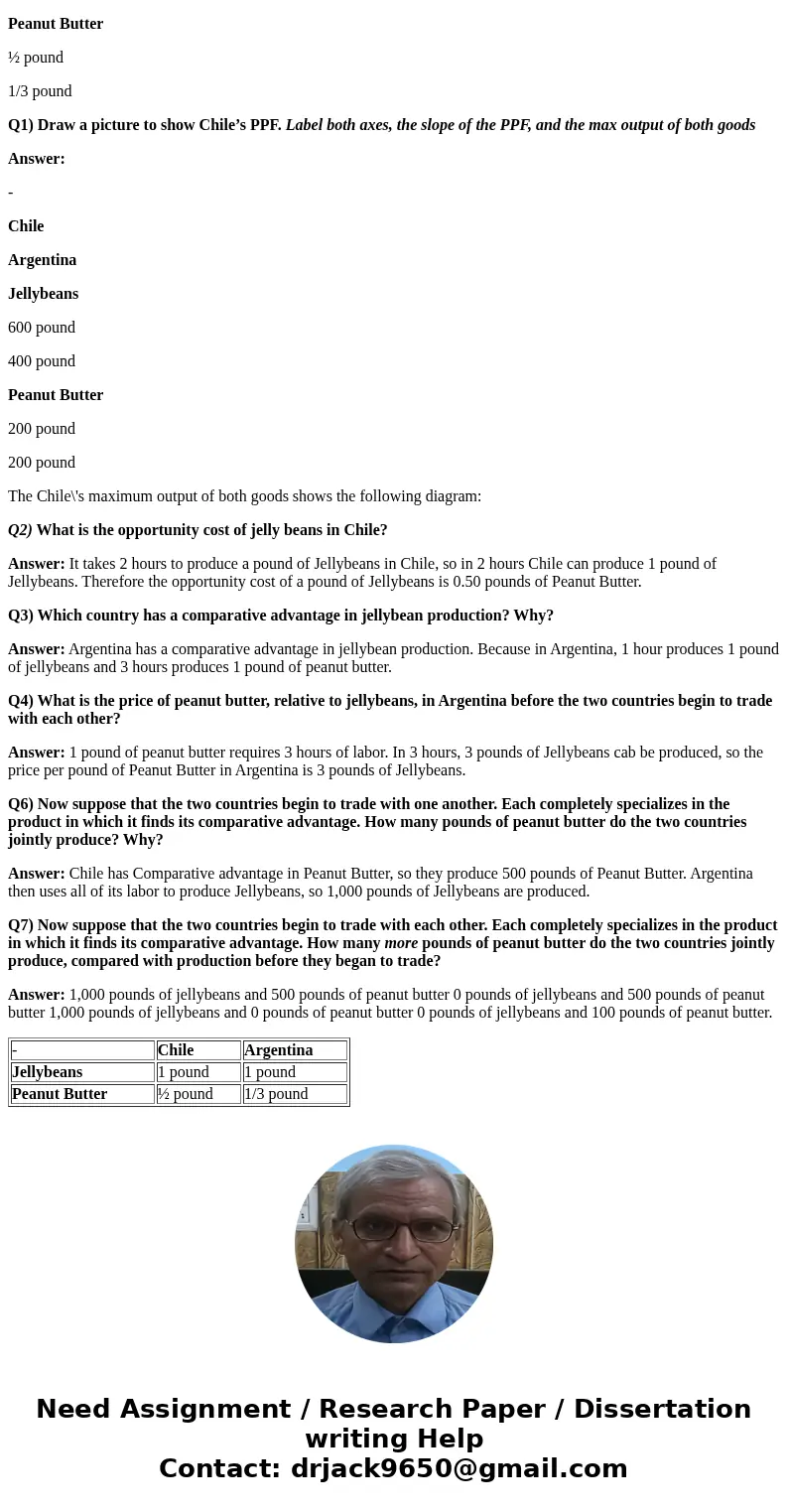Chile and Argentina each produce jellybeans and peanut butte
Chile and Argentina each produce jellybeans and peanut butter using labor as their only resource. Each country has 1,000 hours of labor. In Chile, 1 hour produces 1 pound of jellybeans and 2 hours produce 1 pound of peanut butter. In Argentina, 1 hour produces 1 pound of jellybeans and 3 hours produces 1 pound of peanut butter. When they do not trade with each other, Chile consumes 600 pounds of jellybeans and 200 pounds of peanut butter, and Argentina consumes 400 pounds of jellybeans and 200 pounds of peanut butter.
Q1, Draw a picture to show Chile’s PPF. Label both axes, the slope of the PPF, and the max output of both goods
Q2, What is the opportunity cost of jelly beans in Chile?
Q3, Which country has a comparative advantage in jellybean production? Why?
Q4, What is the price of peanut butter, relative to jellybeans, in Argentina before the two countries begin to trade with each other?
Q5, When Chile engages in free trade with Argentina, what is the lowest value for the price of jellybeans relative to the price of peanut butter? Why?
Q6, Now suppose that the two countries begin to trade with one another. Each completely specializes in the product in which it finds its comparative advantage. How many pounds of peanut butter do the two countries jointly produce? Why?
Q7, Now suppose that the two countries begin to trade with each other. Each completely specializes in the product in which it finds its comparative advantage. How many more pounds of peanut butter do the two countries jointly produce, compared with production before they began to trade?
Q8, Which group will benefit from trade between Chile and Argentina? Below, “Argentina peanut butter producers” = the Argentinian workers who make peanut butter before trade takes place. Explain why.
A) Chilean consumers
B) Argentinean peanut butter producers
C) Argentine consumers
D) Chilean consumers, Argentinean peanut butter producers, and Argentine consumers
Q9, Calculate the real wage in terms of peanut butter in Argentina before trade. Measure real wages using the earnings of 1 hour of labor.
For the questions below, assume that Argentina and Chile are engaged in free trade, and that PjellybeansT/PpeanutbutterT = 2/5.
Q10, Calculate the real wage in terms of peanut butter in Argentina under free trade. Again, measure real wages using the earnings of 1 hour of labor.
Q11, Calculate the wage of Argentina relative to the wage of Chile under free trade.
Solution
Answer:
Chile and Argentina each produce jellybeans and peanut butter using labor as their only resource. Each country has 1,000 hours of labor. In Chile, 1 hour produces 1 pound of jellybeans and 2 hours produce 1 pound of peanut butter. In Argentina, 1 hour produces 1 pound of jellybeans and 3 hours produces 1 pound of peanut butter. When they do not trade with each other, Chile consumes 600 pounds of jellybeans and 200 pounds of peanut butter, and Argentina consumes 400 pounds of jellybeans and 200 pounds of peanut butter.
With 1 hour of labor, the countries can produce as follows:
-
Chile
Argentina
Jellybeans
1 pound
1 pound
Peanut Butter
½ pound
1/3 pound
Q1) Draw a picture to show Chile’s PPF. Label both axes, the slope of the PPF, and the max output of both goods
Answer:
-
Chile
Argentina
Jellybeans
600 pound
400 pound
Peanut Butter
200 pound
200 pound
The Chile\'s maximum output of both goods shows the following diagram:
Q2) What is the opportunity cost of jelly beans in Chile?
Answer: It takes 2 hours to produce a pound of Jellybeans in Chile, so in 2 hours Chile can produce 1 pound of Jellybeans. Therefore the opportunity cost of a pound of Jellybeans is 0.50 pounds of Peanut Butter.
Q3) Which country has a comparative advantage in jellybean production? Why?
Answer: Argentina has a comparative advantage in jellybean production. Because in Argentina, 1 hour produces 1 pound of jellybeans and 3 hours produces 1 pound of peanut butter.
Q4) What is the price of peanut butter, relative to jellybeans, in Argentina before the two countries begin to trade with each other?
Answer: 1 pound of peanut butter requires 3 hours of labor. In 3 hours, 3 pounds of Jellybeans cab be produced, so the price per pound of Peanut Butter in Argentina is 3 pounds of Jellybeans.
Q6) Now suppose that the two countries begin to trade with one another. Each completely specializes in the product in which it finds its comparative advantage. How many pounds of peanut butter do the two countries jointly produce? Why?
Answer: Chile has Comparative advantage in Peanut Butter, so they produce 500 pounds of Peanut Butter. Argentina then uses all of its labor to produce Jellybeans, so 1,000 pounds of Jellybeans are produced.
Q7) Now suppose that the two countries begin to trade with each other. Each completely specializes in the product in which it finds its comparative advantage. How many more pounds of peanut butter do the two countries jointly produce, compared with production before they began to trade?
Answer: 1,000 pounds of jellybeans and 500 pounds of peanut butter 0 pounds of jellybeans and 500 pounds of peanut butter 1,000 pounds of jellybeans and 0 pounds of peanut butter 0 pounds of jellybeans and 100 pounds of peanut butter.
| - | Chile | Argentina |
| Jellybeans | 1 pound | 1 pound |
| Peanut Butter | ½ pound | 1/3 pound |



 Homework Sourse
Homework Sourse